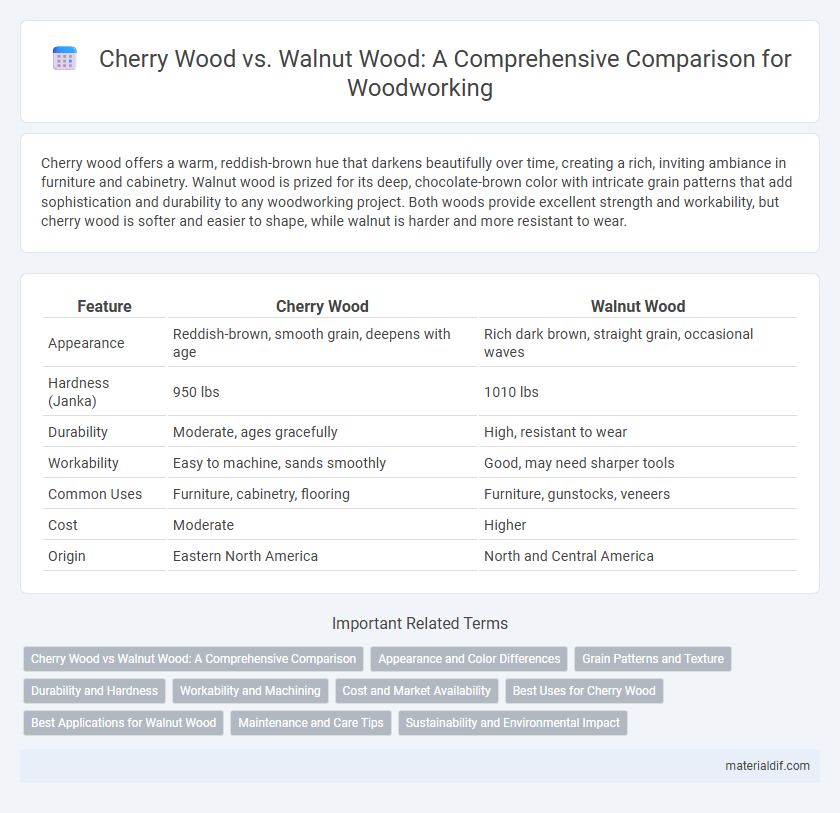Cherry wood offers a warm, reddish-brown hue that darkens beautifully over time, creating a rich, inviting ambiance in furniture and cabinetry. Walnut wood is prized for its deep, chocolate-brown color with intricate grain patterns that add sophistication and durability to any woodworking project. Both woods provide excellent strength and workability, but cherry wood is softer and easier to shape, while walnut is harder and more resistant to wear.
Table of Comparison
| Feature | Cherry Wood | Walnut Wood |
|---|---|---|
| Appearance | Reddish-brown, smooth grain, deepens with age | Rich dark brown, straight grain, occasional waves |
| Hardness (Janka) | 950 lbs | 1010 lbs |
| Durability | Moderate, ages gracefully | High, resistant to wear |
| Workability | Easy to machine, sands smoothly | Good, may need sharper tools |
| Common Uses | Furniture, cabinetry, flooring | Furniture, gunstocks, veneers |
| Cost | Moderate | Higher |
| Origin | Eastern North America | North and Central America |
Cherry Wood vs Walnut Wood: A Comprehensive Comparison
Cherry wood offers a rich, warm reddish-brown hue that deepens with age, making it ideal for elegant furniture and cabinetry, while walnut wood provides a darker, chocolate-brown tone with a slightly purplish cast favored for high-end woodworking projects. In terms of hardness, walnut ranks around 1,010 on the Janka scale, offering robust durability, whereas cherry wood scores slightly lower at approximately 995, balancing strength with easier workability. Both woods feature fine, straight grains but cherry exhibits a smoother texture and better resistance to warping, enhancing its appeal for intricate detailing and long-lasting finishes.
Appearance and Color Differences
Cherry wood features a rich, warm reddish-brown hue that deepens and develops a natural patina over time, enhancing its classic and elegant appearance. Walnut wood offers a darker, chocolate brown color with purplish undertones and a more pronounced grain pattern, lending a luxurious and sophisticated look to furniture and cabinetry. Both woods exhibit fine textures, but cherry presents smoother, more uniform grains, whereas walnut showcases distinctive swirls and burls that create visual depth.
Grain Patterns and Texture
Cherry wood exhibits a fine, straight grain with occasional curly or wavy patterns that create a smooth, even texture prized for its warm, reddish-brown hue. Walnut wood features a more complex, irregular grain with rich, dark brown tones and occasional streaks of purple or gray, providing a striking, coarse texture that stands out in furniture design. Both woods offer unique grain patterns and textures, but cherry tends to be softer and more uniform, while walnut is denser and more varied.
Durability and Hardness
Cherry wood features a Janka hardness rating of approximately 950, offering moderate durability suitable for furniture and cabinetry with a smooth finish that ages gracefully. Walnut wood has a higher Janka hardness around 1,010, providing superior resistance to dents and wear, making it ideal for flooring and high-traffic surfaces. Both woods are durable, but walnut's greater hardness lends it enhanced longevity and resilience in demanding applications.
Workability and Machining
Cherry wood offers excellent workability due to its fine, straight grain and smooth texture, making it ideal for detailed carving and intricate joinery. Walnut wood, while also highly workable, is slightly harder and denser, providing superior durability during machining but requiring sharper tools for clean cuts. Both woods machine well on standard woodworking equipment, with cherry being preferred for precision work and walnut favored for robust, heavy-use furniture components.
Cost and Market Availability
Cherry wood typically commands a higher price due to its rich color and fine grain, making it a luxury choice in woodworking projects. Walnut wood is generally more affordable and widely available, as it grows faster and is more abundant in North America. Market availability for walnut remains steady year-round, whereas cherry wood can experience seasonal fluctuations affecting cost and supply.
Best Uses for Cherry Wood
Cherry wood is prized for its smooth grain, rich reddish-brown color, and natural durability, making it ideal for fine furniture, cabinetry, and upscale interior woodwork. Its moderate hardness and workability allow craftsmen to create detailed carvings and polished finishes, perfect for heirloom pieces and decorative veneers. Cherry wood's resistance to warping and aging gracefully with a warm patina ensures long-lasting beauty in both traditional and contemporary designs.
Best Applications for Walnut Wood
Walnut wood, prized for its rich, dark color and durability, excels in high-end furniture, cabinetry, and flooring due to its strength and resistance to wear. Its fine grain and smooth texture make it ideal for intricate woodwork and decorative veneers, enhancing the aesthetic appeal of luxury interiors. The wood's stability and natural resistance to decay also suit it well for gunstocks, musical instruments, and architectural millwork where both beauty and performance are critical.
Maintenance and Care Tips
Cherry wood requires regular dusting and occasional polishing with a high-quality furniture oil to maintain its rich, reddish tone and smooth surface. Walnut wood benefits from gentle cleaning with a damp cloth and periodic application of a natural wax or oil to enhance its deep, chocolate brown color and prevent drying or cracking. Both hardwoods should be kept away from direct sunlight and excessive moisture to preserve their durability and aesthetic appeal over time.
Sustainability and Environmental Impact
Cherry wood, sourced primarily from sustainably managed forests in North America, offers a renewable option due to its moderate growth rate and effective forest regeneration practices. Walnut wood, often harvested from older trees, has a slower growth cycle, making sustainable yield management critical to prevent deforestation and habitat loss. Both woods benefit from certifications like FSC and PEFC, ensuring responsible forestry practices that minimize environmental impact and promote biodiversity conservation.
Cherry Wood vs Walnut Wood Infographic

 materialdif.com
materialdif.com